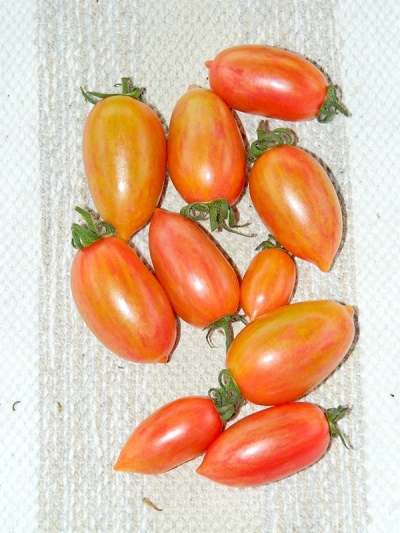
- Authors: Brad Gates, USA
- Name synonyms: Candy Sweet Icicle, Sweet Icicle, Sweet Icicle
- Category: grade
- Growth type: determinant
- Appointment: universal
- Ripening period: mid-early
- Ripening time, days: 100-110
- Growing conditions: for open ground, for greenhouses
- Bush size: medium-sized
- Bush height, cm: 120
Sweet Icicle Candy was bred on a California farm owned by a true artist. Black, orange, marbled tomatoes of his selection resemble a scattering of exotic fruits.
Breeding history
The author of the Candy Sweet Icicle variety is Brad Gates, owner of Wild Boar Farms, which is located in Napa Valley, California, USA. The company specializes in the production of unusual varieties of tomatoes - only the brightest and most daring. Special attention is paid to taste - it must be exquisite. The company uses only environmentally friendly methods of growing its plants.
The variety is not included in the State Register of Varieties of the Russian Federation.
Description of the variety
Tomato bush Sweets sweet icicles thin, graceful, reaches a maximum height of 120 cm. The variety is determinant, which means that at the top the fruit forms an ovary with fruits and does not grow further. Between the ovaries there are less than 3 true leaves, and the first fruits are laid after 6 leaves, and not after 8-9, as in indeterminate varieties.
The tomato is a variety, not a hybrid, so you can harvest your seeds in the fall. They will grow quality plants that retain their maternal characteristics. Splitting of traits, which happens even with very resistant crop varieties, may produce yellow fruits.
The main qualities of the fruit
The variety forms small, weighing up to 40 g, creamy fruits with a predatory pointed tip and a beautiful color: red background + marble gold stains. The shape is round, curved, the skin is dense, elastic, strong. The fruits are abundant. Chambers with seeds are clearly visible, a pronounced segmentation is characteristic of tomatoes bred by Brad Gates.
Taste characteristics
The fruits are sweet, aromatic and fragrant, with a bright special taste, fully justifying their name. On the palate, spicy, exotic fruity notes are read. Good for fresh consumption, salads, side dishes, desserts. Thanks to their size, shape and color, they are excellent in one-piece workpieces. Sufficiently juicy, suitable for making ketchups and marinades. The variety does not limit its use in any way.
Ripening and fruiting
The variety is medium early, the harvest will ripen 100-110 days after sowing the seeds. If you sow seedlings on March 1, and plant seedlings in open ground in mid-May, then the first fruits can be removed already in mid-to-late June.
Yield
The variety is generous, willingly sets fruits, up to 15-17 tomatoes can ripen on one cluster. No specific yield figures are given, but the grower and growers describe the productivity of the shrubs as impressive. For early maturing determinant varieties, the normal yield is 1-5 kg per bush.
The timing of planting seedlings and planting in the ground
The tomato belongs to the early group. Such plants are more compact than late ones, less sensitive to lack of light, so they can be sown for seedlings even at the end of February. However, the recommended deadline is March 1-15. Sowing later will prevent the variety from developing its early fruiting potential. Seedlings are planted in the soil in the second half of May, but they are guided by the conditions in a particular area.In Western and Eastern Siberia, tomatoes are planted in open ground no earlier than June 1, when the threat of recurrent frosts has completely passed.

Growing tomato seedlings is an extremely important process, because it largely depends on whether the gardener will be able to harvest at all. All aspects must be taken into account, from seedbed preparation to planting in the ground.
Landing scheme
Sweet icicles are compact bushes of the Candy variety, so they are planted at a distance of 50 cm from each other, in the aisles also 50 cm. For 1 sq. m can accommodate 6 bushes.

Growing and care
The variety is determinant, therefore, careful design of the bush will be required so that the plant does not spend its little energy on the formation of stepchildren. Leave no more than 1-2 main branches, all stepsons are removed, cutting them off so that a stump of 2 cm remains.
Can be grown outdoors or in greenhouses. Not suitable for year-round cultivation.
It is very resistant to disease, but thermophilic. In cold, damp conditions, the leaves may begin to show signs of fungal diseases.
To obtain the maximum yield and a set of sugar content, the tomato is intensively fed with mineral fertilizers: superphosphate, ash solution, calcium nitrate. Avoid excess nitrogen and calcium deficiency.
The variety needs garters and supports.
Water abundantly, but always waiting for the soil to dry out between waterings.
To prevent the appearance of apical rot, seedlings are sprayed with calcium nitrate within a week immediately after planting in the ground, or treated with "Fitosporin".




A plant needs different micronutrients at each stage of growth. All fertilizers can be divided into two groups: mineral and organic. Folk remedies are often used: iodine, yeast, bird droppings, eggshells.
It is important to observe the rate and period of feeding. This also applies to folk remedies and organic fertilizers.


Review overview
The variety is liked by gardeners for its bountiful harvest, unusual taste and beauty of the fruit. The tomato has stable characteristics, it is able to show itself even in cold summers in the open field. Stable sugar content is noted by amateurs from different countries, including at home, in the United States. The variety has excellent genetics. However, the most delicious fruits will be in hot summer, at temperatures above + 27 ° С and competent feeding with nitrogen minimization. The fruits are so tasty that they are consumed mostly raw, they do not live up to harvesting.

























































































